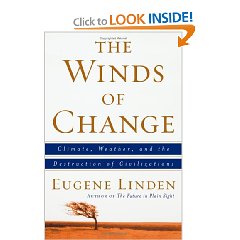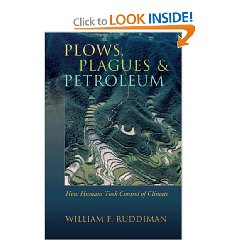This book just edges out “The Weather Makers” by a slight margin that has everything to do with the specific gems I pulled from both and is therefore a very personal even random order. The two together are superior to “When the Rivers Run Dry” and “Plows, Plagues, and Petroleum,” the “runners up” in my four book survey.
From my personal focus on non-fiction about national security and prosperity, the authors focus on the fact that climate change can undermine legitimate governments by fostering water scarcity, disease, migration, and hence poverty, was highly relevant.
The author is wonderfully contextual in declaring that the real weapons of mass destruction are these: disease, migration, conflict, and famine. He gives credit to David Key's “Catastrophe,” a book I reviewed some time ago, very favorably.
The author identifies climate as the ultimate context for the human playing field, and points out that a series of El Ni�o's in the 19th century may well have killed more people than the two World Wars in the 20th century.
Thus, the author does not show alarm about Global Warming per se, as do many of the more scientific observers, but rather about the manner in which global warming leads directly to the spread of disease, often sparked by drought.
He notes–and this is in the aftermath of the global fright over SARS–that Asia historically produces cataclysmic plagues from weather and water related disease, including the Black Death in 1332. He specifically identifies water as the gold of tomorrow, hence Canada (or separatist Quebec) and Scotland will be quite heavenly.
The chart on page 89 is alone worth the price of the book–showing the rate of change in each decade from the 1950's (10,000 years) to 1980's (100 years) to 1985 (50 years) to 1992 (3 years).
On page 190, without direct reference to the Cheney-Bush regime, he could not have described them better: “Climate's capacity to inflict misery rises steadily when arrogance and ideology hinder a society's adjustments to extreme weather.” This is consistent with other books I have reviewed that point out that the difference between disaster (e.g. New Orleans flooding) and catastrophe (e.g. the U.S. Government sitting on its hands) is mind-set–planning mind-set, preparation mind-set, and response mind-set.
Of the four books, this one is the best for the warrior-thinkers as it brings forth the ideas of Mike Davis and on pages 199-200 discusses the triangle of State Decapacitation; Household Poverty; and Ecological Poverty. In the author's view, it is social and political misjudgments that “load” the climate “gun.”
The author is consistent with other books I have reviewed for Amazon in pointing out that scientific alarm is sharply at odds with public indifference to climate. Those that think Al Gore will get a second shot from his book (bad) and movie (good) on the environment are delusional.
The author is gently vitriolic in suggesting that governments that claim that climate changes are going to be moderate and incremental as either delusional or deceptive–in today's (2006) White House, both would apply.
The absolute high point of this book–and one that singles the author's perception out as being acute, is when he provides an extremely provocative discussion of the need for “science in real time” in order to detect and understand changes in the deep ocean and high atmosphere that otherwise might not be noticed or known for 3-5 years–which, as the chart on page 89 shows, are now a statistically significant period for climate change. Here I have to give the White House *very* high marks, for their attempts to get all nations to share information from earth observation systems including undersea sensors, sea buoys, ground sensors, aviation sensors, and satellite sensors. That project has been very successful and is now being extended to monitor disease. The problem is that the White House, while advancing the collection of data, refuses to acknowledge the meaning of the data that is arriving.
Citing Kerry Emmanuel of MIT, the author notes that hurricanes have gotten twice as intense in the past 30 years. He goes on to note that Los Angeles is “hosed” in that the best case scenario for that city calls for it to suffer a 50% drop in available water by 2050, absent a major program to desalinate sea water and save the aquifers from further depletion.
According to the author, 9/11 opened a lot of eyes, and actually made some people more sensitive (but see also my reviews of the four books in the series beginning with “The Republican War on Science”). He cites John Dutton of Penn State as stating that $2.7T of the total US economy of $10T is subject to weather related loss of revenue.
As he draws to a close, he gladdens my heart in pointing out that insurance companies are now getting wise, and starting to withhold insurance coverage from the Exxon's of the world with respect to lawsuits for damages and liability in the case of climate change. Just as tobacco companies were ultimately held accountable for covering up the lung cancer risks, so does the author foresee the day when both oil and coal companies are buried by punitive law suits related to their negative impact on the climate and their lies to the courts and the legislatures (remember, its not the sex, it's the lying about the sex that draws the greatest punishment).
The author ends the book with a fine chronology, 18 pages long, on changes in climate and changes in views about climate change from the 1950's to date.
In addition to this book I would certainly recommend E. O. Wilson's “The Future of Life” and J. F. Rischard's “HIGH NOON: 20 Global Problems, 20 Years to Solve Them.”









